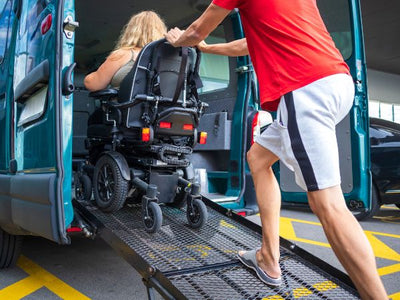Learning how to choose a mobility scooter that's designed to go the distance is often easier said than done, but a little bit of research can go a long way.
As anyone who already owns a mobility scooter already knows, these machines have powers that go far beyond simply getting someone from A to B. For people who live with a disability or health issue that restricts their physical movements, access to a mobility scooter can work wonders when it comes to revolutionising how they navigate the world.
What’s more is that these machines have been proven to dramatically enhance the owner’s independence and quality of life. Loneliness and social isolation are thought to be silent killers here in Australia, but with the help of a mobility scooter, going out for coffee with friends or heading to the shops becomes much less stressful, and far more enjoyable - as it should be.
However, all these benefits hinge on the person’s ability to purchase a mobility scooter that best fits their needs, health conditions, living environment and overall lifestyle. In fact, learning how to choose a mobility scooter is crucial for finding the right fit.

Understanding How Mobility Scooters Work
In simple terms, a mobility scooter is an electric vehicle and mobility aid mostly auxiliary to a power wheelchair but configured like a motor scooter. Mobility scooters differ from motorised wheelchairs in that they are usually much cheaper, somewhat easier to move across uneven ground and are far more customisable.
Generally, mobility scooters are built for people who have trouble walking or getting around, but don't always need a motorised wheelchair. In turn, this makes them very popular with people who have a wide range of medical conditions, long term injuries or a disability, particularly for those who can’t stand for extended periods of time or those not permitted to drive cars for medical reasons.
A mobility scooter has a seat over two rear wheels, a flat area for the feet and handlebars in front to turn one or two steerable wheels. The seat may swivel to allow access when the front is blocked by the handlebars, and mobility scooters are usually battery powered. While there are several types of mobility scooters available on the market today, their basic functions remain the same.
While highly customisable, mobility scooters generally come in three sizes: small, medium and large. Smaller models are often quite portable and can even fold up like a bicycle, but are usually capped at distances of 25 kilometres, up to 110 kilograms and have a top speed of roughly 10 to 13 kilometres per hour.
Medium mobility scooter models have a larger battery range, and a full charge can last anywhere between 25 to 35 kilometres. With a user weight capacity of up to 150kg, they also have slower top speeds of up to 10 kilometres per hour. As they are physically larger, the trade off is usually enhanced safety features, such as mirrors, lights and even indicators for improved visibility.
Finally, top of the range mobility scooters, or the largest varieties on the market, are bigger, faster and last longer between charges. With some offering top speeds of up to 15 kilometres per hour, they can also be operated for up to 50 kilometres at a time and have weight capacities up to 180kg. Along with all the bells and whistles seen on medium models, larger mobility scooters also have accessories like shopping baskets, improved suspension and even hand brakes.
However, it’s important to keep in mind that bigger isn’t always better and that learning how to choose a mobility scooter that’s right for you will boil down to a number of different factors. In fact, if you fail to tick all the boxes, you may end up with a vehicle that doesn’t match your needs, expectations or requirements - so what should you consider before making a purchase?
Five Things To Consider Before Selecting A Mobility Scooter
If you’re new to the world of mobility scooters, many people make the mistake of approaching a purchase with a ‘one size fits all’ approach. In reality, there are many brands, sizes, makes and models to consider, with each one tailored to cater to certain mobility issues, lifestyles and even terrains.
As such, it’s important to cover a few key areas before you start shopping for new wheels. If you require assistance transferring from a bed to a chair, plan on using a mobility scooter to get around indoors, have vision impairments or lack the upper body strength required to balance and steer a scooter, then a mobility scooter may not be the right choice for you.
For those who don’t have any of these restrictions, then other considerations that apply when learning how to choose a mobility scooter should include the following.
Your Body Type - Your height, weight and any physical impairments will all have a part to play when it comes to selecting the perfect mobility scooter. If you’re on the shorter side, larger models may not be the best fit as you’ll need to be able to comfortably access the controls and steering components. In contrast, weight capacities will also apply as well.
Landscape Varieties - For some people, a small mobility scooter designed primarily for short trips may be ideal, while others would prefer a larger option that is capable of driving on gravel pathways or bush tracks in their local park. If you live in a hilly area, it’s also important to consider any restrictions a mobility scooter may have with navigating inclines.
Style Of Seating - For some people, staying seated for long amounts of time can be incredibly uncomfortable, particularly if they are used to having a certain type of mobility chair at home. As such, selecting a mobility scooter that’s equipped with a supportive, well-padded and contoured seat is a must, but this is a feature usually limited to larger models.
Portable Options - If you don’t need the assistance of a mobility scooter on a day to day basis or plan on taking one with you on car trips or even aeroplanes, then exploring your options for a foldable and more portable machine is usually the way to go. In contrast, larger models can be harder to transport and store, so consider where it will live when it’s not in use.
Distance Requirements - How far you plan to travel on your new mobility scooter will have an enormous impact on choosing the right type of model for your lifestyle. Think about how long you need the battery to last for between charges, how fast you want to travel and the distance between your departure points and destinations.
Ultimately, a mobility scooter is a big investment that has the potential to change your life for the better, so it’s important to do everything in your power to select the right type of model from day one and avoid a potential headache down the track.
While there’s plenty of retail outlets available to purchase a mobility scooter from, aim to partner with an expert not just on the products themselves, but an operator who can provide an in-home trial and after sales care, particularly for things like repairs - but where do you find one?
Meet The Local Experts Who Specialise In Mobility
At Equip U, we see a disability as a possibility and have made it our mission to go above and beyond the standard offerings from other retailers who stock devices and tools to improve mobility.
Our point of difference is that we don’t just stock mobility scooters and other accessories, but we also offer in-home trials to residents who live in Queensland. We believe that access to these types of products shouldn’t be limited based on where you live, and being NDIS registered, we can provide funding options as well.
Ultimately, it’s our mission to work with you to bring your vision for improved mobility to life. Should you have any queries about the types of products we offer or how they work, or would like to schedule a free at home product demonstration, please get in touch with us today.





